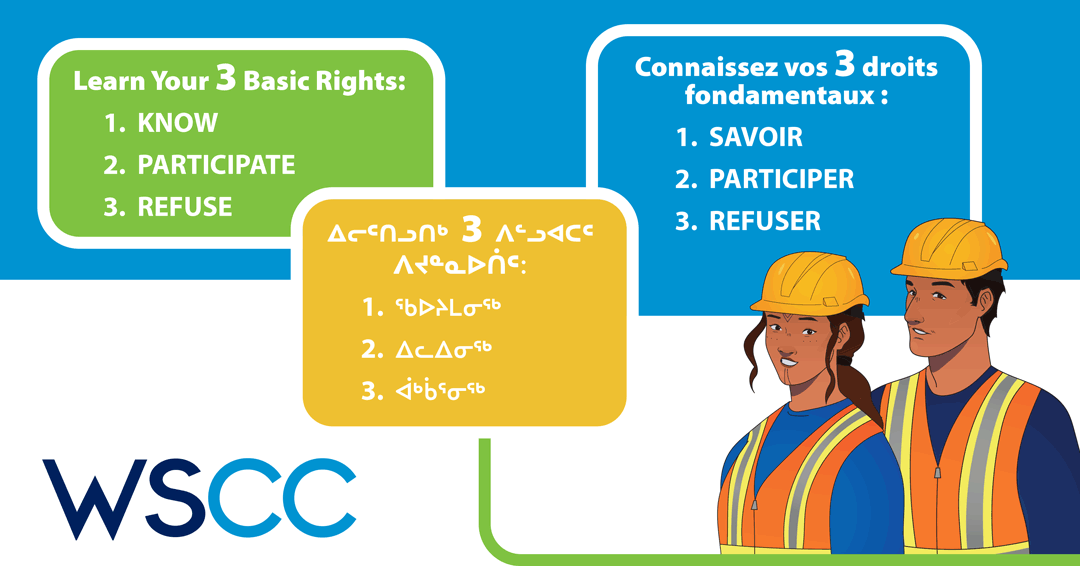
Working safely is everybody’s job, and every worker has the right to a safe workplace. Understanding the rights and responsibilities of every worker is a foundational part of workplace safety training.
3 Worker Rights
Before starting work, everyone should understand their three fundamental rights.
- The Right to Know – You have the right to know how to do your job safely. Before you start working, your supervisor must provide training on:
- What hazards are in your worksite.
- What you need to do to make sure you’re working safely.
- Where to find emergency supplies.
- What to do in case of an emergency.
- How to report injuries or safety concerns.
- How to request or take part in the proper training needed to do your work safely.
- The Right to Participate – You have the right to be involved at work to make sure your workplace is safe. This may look like:
- Raising a concern for the safety of you or your coworker or identifying something unsafe and making suggestions on how to make it safer. E.g. if there is always ice on the front step, you have the right to inform your supervisor and make suggestions to make it safer, like keeping a bag of sand by the door so it is easy for people to sprinkle it on the ice.
- In a business with 20 or fewer employees, you can become the Safety Representative.
- In a business with more than 20 employees, you have the right to join the Safety Committee (often called the OHS Committee or the JOSH Committee).
- The Right to Refuse – You have the right to say NO to work that feels unsafe for you and your co-workers.
- If you ever feel unsafe or haven’t been trained to do a task safely, you have the right to stop working and inform your supervisor of your concerns.
- If the work you are doing puts you in unusual danger (e.g. a workplace hazard that is not part of your everyday work and/or you are not trained to manage), you have the right to refuse that work, informing your supervisor right away.
- It is important to follow the correct steps to refuse unsafe work.
Worker Responsibilities:
Everyone is responsible for workplace safety. While employers and supervisors share a responsibility for the safety of their workers, it is essential that every worker takes an active role in maintaining a safe and healthy workplace.
Training and Education
It is your employer and supervisor’s responsibility to provide you with all of the training you need to understand how to do your job safely. They must show you how to do all of the duties assigned to you safely. It is your responsibility to follow the instructions your supervisor provides. You should understand your duties well enough to explain them to your supervisor.
When you are not sure, ask for training
It is important that every worker understands how to do every task assigned to them safely. Whether you’ve forgotten or have not yet been trained to do your job, never be afraid to ask. Your supervisor may not know that you need more training. If you feel that you or someone you work with needs more training to do a job safely, tell your supervisor. Don’t perform any task until you receive proper training.
Follow procedures
Procedures are available to ensure everyone understands how to do a task properly. Even procedures that may not have “safety” in the title should still have instructions that ensure tasks are always done safely. Learn and apply all safety rules and procedures required for your job. This includes ensuring all equipment and personal protective equipment (PPE) is in good working order. If you ever feel that a procedure does not protect the safety of workers, you have the right to make suggestions to make the procedures safer.
Report incidents, unsafe conditions and unsafe work practices
If you see or are involved in an incident, if work conditions become unsafe, if you see unsafe work practices, or if equipment is broken or not in safe working order, report them to your supervisor immediately.
Know your work site Emergency Response Plan
Employers must make sure everyone knows what to do in an emergency; whether it is a fire alarm, power failure, or other situation. Employers must ensure all workers are familiar with the emergency response plan, and that they provide a copy that is easily accessible to every employee.


